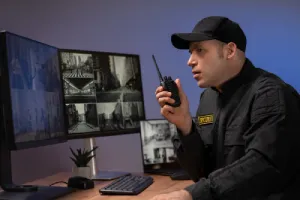Tasks and Priorities in First 15 Minutes
The first 15 minutes of any incident can make or break the response. In the Security Control Room (SCR), these minutes are not just critical, they are decisive. As an SCR Operator, your calm, structured, and compliant actions during this window determine how well your team controls the situation and how effectively risks are contained.
Whether it’s a fire alarm, a medical emergency, a power failure, or a security breach, your first steps must follow procedure, not panic. The Security Industry Authority (SIA) and Approved Contractor Scheme (ACS) expect operators to act quickly, accurately, and in full alignment with company and regulatory standards.

Why the First 15 Minutes Matter
Incidents can escalate quickly if not handled with precision. The control room acts as the command centre, guiding every move of the on-ground team. The way you organise your first few minutes decides whether the incident is resolved efficiently or spirals into confusion.
Statistic to Know: According to ACS operational audits, over 80 percent of critical incidents are stabilised within the first 15 minutes when control rooms follow structured response procedures.
Example:
During a large event, a security control room receives multiple reports of a power failure. Instead of reacting chaotically, the operator immediately verifies the fault, contacts maintenance, dispatches officers to key areas, and communicates with management. Within 10 minutes, backup systems activate, public safety is maintained, and operations continue smoothly.
The 15-Minute Response Framework
Every incident is different, but your response structure should always follow the same professional flow, Assess, Communicate, Coordinate, and Record.
| Phase | Key Actions | Purpose |
|---|---|---|
| Assess (0–3 mins) | Identify the type of incident using CCTV, alarms, or reports. Confirm if it’s genuine or false. | Prevents overreaction and ensures a proportionate response. |
| Communicate (3–7 mins) | Notify relevant teams, management, or emergency services. Give clear, concise updates. | Keeps everyone aligned and avoids duplication of effort. |
| Coordinate (7–12 mins) | Direct officers, assign roles, and manage movement on site. Prioritise safety above all. | Establishes control and ensures safety protocols are followed. |
| Record (12–15 mins) | Log all events, decisions, and communications accurately. Update incident reports in real time. | Supports compliance with BSI and NSI audit requirements. |
Tip: Keep a checklist or quick-reference guide near your workstation. When adrenaline is high, structured steps prevent mistakes.
Key Priorities to Focus On
In those crucial first minutes, focus on what matters most.
Safety First: Protect life before property. Always ensure your team and the public are safe before addressing the cause.
Clarity Over Speed: Acting fast is important, but accuracy is vital. Don’t rush without verifying facts.
Follow Protocol: Stick to your site’s standard operating procedures (SOPs), they’re designed for consistency and compliance.
Communicate Clearly: Keep radio communication brief, factual, and calm. Avoid speculation or emotional responses.
Stay Composed: Stress is contagious. If you stay calm, your team will too.
Think Ahead: While handling the current issue, anticipate possible escalation points, evacuation, lockdown, or external involvement.
Key Consideration:
Every action you take must be defensible and compliant with SIA and ACS operational codes. Poor documentation or deviation from SOPs can lead to audit failures or disciplinary action.
Real-World Example: The Calm Operator
During a weekday morning, an SCR Operator at a large business park notices an intruder alarm. Instead of immediately triggering a full alert, the operator checks CCTV, identifies a delivery driver entering the wrong door, and confirms with ground staff. The situation is resolved within five minutes without panic or escalation.
This is a perfect example of professional composure and correct prioritisation, the operator stayed calm, followed procedure, and avoided unnecessary disruption while maintaining full compliance with BSI monitoring standards.
Overcoming Challenges in the First 15 Minutes
Even the most experienced SCR Operators face pressure when the first alerts hit. The key is not avoiding challenges, but knowing how to stay calm and prioritise effectively when they appear.
Multiple Alarms at Once: When several systems trigger simultaneously, focus on what matters most, life-safety incidents first, such as fire, medical, or evacuation alarms.
Unclear or Incomplete Information: Don’t jump to conclusions. Verify details using CCTV, team confirmation, or sensor data before taking action.
Pressure from Clients or Management: Stay factual, professional, and calm. Make decisions based on confirmed information, not assumptions or urgency from others.
Communication Overload: Too many voices can confuse. If possible, assign one team member to manage radio traffic while you focus on coordination.
Tip: When things get hectic, trust your training. Follow your response checklist, stay composed, and remember, clarity always beats chaos.
Technology That Keeps You Ahead
Modern control rooms rely on smart tools to stay efficient under pressure. Knowing your systems inside out can save valuable seconds and prevent mistakes.
Digital Log Systems: Record every decision in real time for full traceability and compliance with BSI and NSI standards.
Automated Alerts: Use technology to help prioritise incidents by severity or risk level, allowing faster and more structured responses.
Response Templates: Pre-set communication templates ensure you deliver consistent, compliant messages to responders and management.
Tip: Master your systems like a pilot knows their cockpit. Quick access to the right tools can turn a tense situation into a controlled one.
Building Confidence When It Counts
Confidence in the control room isn’t about bravado, it’s about preparation. The more you train, the faster and more effectively you’ll respond when real incidents strike.
Train Regularly: Repetition builds instinct. Frequent drills improve speed, accuracy, and teamwork.
Review and Refine: After each scenario or live incident, analyse what went well and where improvements can be made.
Stay Informed: Keep up to date with changes in procedures, technology, and site risks.
Statistic to Know: Control rooms that run monthly 15-minute response drills achieve a 35 percent faster incident resolution rate, according to internal ACS audit findings.
Example: After a suspicious package drill at a major transport hub, the SCR team discovered that their logging system slowed response time. They improved their process and shaved six minutes off in the next drill, a major win for both safety and compliance.
Staying in Command When It Matters Most
The first 15 minutes of any incident are your moment to lead. How you think, speak, and act during this window sets the tone for everyone else. In those high-pressure moments, a calm, structured SCR Operator turns confusion into control.
Stay focused, stay steady, and stick to your training. Every instruction you give, every log you record, and every decision you make contributes to safety, compliance, and trust.
Remember:
A professional operator doesn’t just react, they respond with purpose. Clear communication, confident action, and accurate reporting are your strongest tools for maintaining control and ensuring full compliance with SIA, ACS, BSI, and NSI operational standards.

